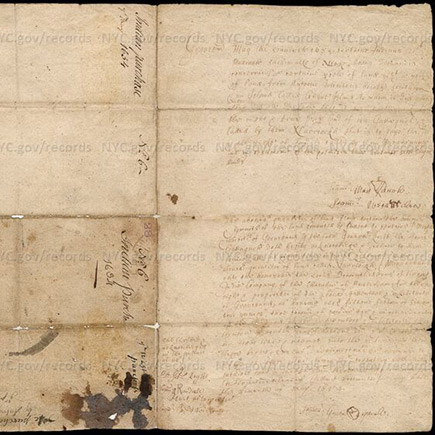Port City: First Encounters
Land Rights and Usage
Social Studies


Objectives
Social Studies
Students will:
- Learn about the culture of the Lenape
- Deepen their understanding of the Algonquian speaking group, the Lenape, and understand an alternative use of weapons in the Lenape culture
- Learn how the Dutch settled and “bought up land” (or colonized land) in New Amsterdam and early New York
Social Emotional Learning
Students will:
- Broaden their vocabulary for describing feelings
- Develop empathy skills by “putting themselves into the shoes” of people from another culture
Materials
- Station cards with descriptions of what students will be doing at each station
- Printed station booklets for students to record their responses
- Writing utensil
- Classroom timer
- Hi-res images/print outs of the Lenape Club and the Purchase of Meadow & Upland (deed)
- Magnifying glasses
- Information about the Lenape Club and the Deed to Coney Island from the Museum’s website
Standards
Ask and answer questions to demonstrate understanding of a text, referring explicitly to the text as the basis for the answers.
Compare and contrast a firsthand and secondhand account of the same event or topic; describe the differences in focus and the information provided.
Explain the relationships or interactions between two or more individuals, events, ideas, or concepts in a historical, scientific, or technical text based on specific information in the text.
- Exploration
- Share
- Discuss
- Connection
- Closing Share
Procedures
This lesson follows an inquiry-based and student-centered approach to learning and development. Students are expected to generate questions that help guide the exploration.
Students will go through three stations, spending five minutes at each, to understand aspects of the Lenape and the Dutch and develop questions about the Lenape Club and the Purchase of Meadow & Upland. Explain that we believe the Lenape Club was used ceremonially and as a tool for diplomacy. Explain what a deed is and why this document was made by the Dutch. Ask the students to see if they can find a signature from a Lenape person. The three stations will be as follows: (15 minutes)
Station #1: Different Understanding of Words
Think of a time when you have had a misunderstanding or miscommunication with a friend, family member, or teacher. Can you remember a time when you thought that you explained something clearly or asked a clear question but the response showed that the person understood your instructions or questions differently? Is there a time someone told you something but you thought they meant something else? For example, maybe your brother is always very unclear with directions and says, “Let’s meet over there.” But you can never find each other because you have a different understanding of the words “over there.” Write about this in the Station 1 section of your “Lenape and the Dutch Encounter Booklet.”
Station #2: Archaeological Exploration (of the Lenape Club and The Purchase of Meadow & Upland
Like an archaeologist, look carefully at the pictures at the top of this lesson of artifacts found in the New York area. They were made by the Lenape people. What do you think they are and why? Use the magnifying glasses at this station to explore the fine details. Remember that archaeologists pay very close attention to the details and always have a reason for their statements. Write about your findings and reasons in the Station #2 section of your “Lenape and the Dutch Encounter Booklet.”
Station #3: What would you do if…?
What would you do if you and your friends were playing kickball during recess but while you took a break another group of students took the ball and the field? Consider your choices for responding. Would your choice match the action done against you? What is your rationale and reasoning?
Have students share their responses from the three stations with a partner.
Have a couple of students share their ideas about what they thought the two artifacts were. Ask students to make connections between the two objects. Help bridge the connections and clarify any misunderstandings. Depending on students’ prior understandings, it may be necessary to prepare additional materials to provide more information about the interactions between the Dutch and the Lenape.
After the discussion, have students consider the connection between the task in Station #1 and Station #3. Students can record their responses in the “Reflection section of their “Lenape and the Dutch Encounter Booklet.”
Have students share what they felt the connection was. Explain that different groups have different understandings of “buying” and “owning” land and that historians must use clues from documents and objects to understand how different events occurred. Explain that the Lenape were not being fooled but negotiated the best deals that they could, sometimes using agreements to control where Europeans settled. Discuss that there are many interpretations of historical artifacts and that ideas about land and ownership change across both time, place, and cultures.
For more information about the way land was transferred between the Lenape and the Dutch, see the following article about Staten Island. Although there may have been different understandings about land ownership, there was also pressure and force involved in the land transfer.
Acknowledgements
New York at Its Core lesson plans were developed in conjunction with a focus group of K-12 New York City teachers from public, private, and parochial schools: Maryann Cooke, Maria Diaz, Sasha Domnitz, William Fong, Gina Giannone, Peter Lapre, Edina Lawson, James Randle, Judy Sokolow, and Matt Thoren. We thank the New York City Department of Education’s Office of Social Studies for supporting the public school teachers’ participation.

